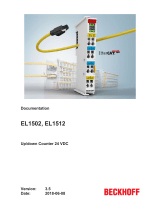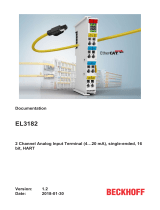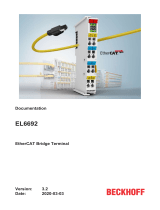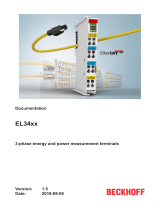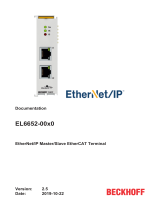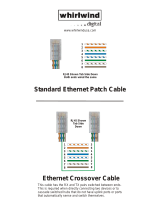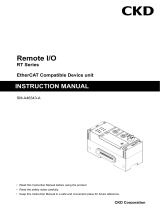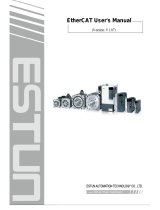
Documentation
EL6601, EL6614
Switch Terminals for Ethernet
4.2
2019-05-03
Version:
Date:


Table of contents
EL6601, EL6614 3Version: 4.2
Table of contents
1 Foreword ....................................................................................................................................................5
1.1 Notes on the documentation..............................................................................................................5
1.2 Safety instructions .............................................................................................................................6
1.3 Documentation issue status ..............................................................................................................7
1.4 Version identification of EtherCAT devices .......................................................................................8
2 Product overview.....................................................................................................................................12
2.1 Introduction......................................................................................................................................12
2.2 Technical data .................................................................................................................................14
2.3 Basic function principles ..................................................................................................................14
2.4 EL66xx - Non Realtime....................................................................................................................17
2.5 EL66xx and Beckhoff network variables..........................................................................................22
2.5.1 Explanation network variables ......................................................................................... 22
2.5.2 Settings in the System Manager...................................................................................... 24
2.5.3 Notes ............................................................................................................................... 25
2.5.4 Suppress publisher .......................................................................................................... 25
2.5.5 Filter subscribers ............................................................................................................. 26
2.5.6 Setting up TwinCAT 2.10................................................................................................. 26
2.5.7 Setting up TwinCAT 2.11................................................................................................. 29
2.6 Configuration in the CX20x0 & CX50x0 system ..............................................................................30
3 Basics communication ...........................................................................................................................33
3.1 EtherCAT basics..............................................................................................................................33
3.2 EtherCAT cabling – wire-bound.......................................................................................................33
3.3 General notes for setting the watchdog...........................................................................................34
3.4 EtherCAT State Machine.................................................................................................................36
3.5 CoE Interface...................................................................................................................................38
3.6 Distributed Clock .............................................................................................................................43
4 Mounting and wiring................................................................................................................................44
4.1 Recommended mounting rails.........................................................................................................44
4.2 Mounting and demounting - terminals with front unlocking .............................................................44
4.3 Positioning of passive Terminals .....................................................................................................45
4.4 Installation positions ........................................................................................................................46
4.5 ATEX - Special conditions (extended temperature range) ..............................................................48
4.6 ATEX Documentation ......................................................................................................................49
5 Commissioning........................................................................................................................................50
5.1 TwinCAT Development Environment ..............................................................................................50
5.1.1 Installation of the TwinCAT real-time driver..................................................................... 50
5.1.2 Notes regarding ESI device description........................................................................... 56
5.1.3 OFFLINE configuration creation ...................................................................................... 60
5.1.4 ONLINE configuration creation ........................................................................................ 65
5.1.5 EtherCAT subscriber configuration.................................................................................. 73
5.2 General Notes - EtherCAT Slave Application..................................................................................82
5.3 Object description and parameterization .........................................................................................90
5.3.1 Objects for commissioning............................................................................................... 90

Table of contents
EL6601, EL66144 Version: 4.2
5.3.2 Objects for regular operation ........................................................................................... 91
5.3.3 Standard objects (0x1000-0x1FFF) ................................................................................. 91
5.3.4 Profile-specific objects (0x6000-0xFFFF) ........................................................................ 94
5.4 Beckhoff network variables..............................................................................................................97
5.4.1 Introduction ...................................................................................................................... 97
5.4.2 Configuration of the Publisher ......................................................................................... 98
5.4.3 Configuration of the Subscriber ..................................................................................... 101
5.4.4 Beckhoff network variables - Settings............................................................................ 105
6 Application samples..............................................................................................................................113
6.1 Sample programs ..........................................................................................................................113
6.2 Application sample - network printer .............................................................................................114
6.3 Application sample - Service interface with remote desktop .........................................................119
6.4 Application sample - Lower-level control system...........................................................................129
6.5 Application sample – setting up an EtherCAT Master PC as a network bridge.............................134
6.6 Application sample - Flexible Ethernet Port...................................................................................139
7 Appendix ................................................................................................................................................144
7.1 UL notice .......................................................................................................................................144
7.2 Firmware compatibility...................................................................................................................145
7.3 Firmware Update EL/ES/EM/ELM/EPxxxx ....................................................................................146
7.3.1 Device description ESI file/XML..................................................................................... 147
7.3.2 Firmware explanation .................................................................................................... 150
7.3.3 Updating controller firmware *.efw................................................................................. 151
7.3.4 FPGA firmware *.rbf....................................................................................................... 152
7.3.5 Simultaneous updating of several EtherCAT devices.................................................... 156
7.4 Restoring the delivery state ...........................................................................................................157
7.5 Support and Service ......................................................................................................................158

Foreword
EL6601, EL6614 5Version: 4.2
1 Foreword
1.1 Notes on the documentation
Intended audience
This description is only intended for the use of trained specialists in control and automation engineering who
are familiar with the applicable national standards.
It is essential that the documentation and the following notes and explanations are followed when installing
and commissioning these components.
It is the duty of the technical personnel to use the documentation published at the respective time of each
installation and commissioning.
The responsible staff must ensure that the application or use of the products described satisfy all the
requirements for safety, including all the relevant laws, regulations, guidelines and standards.
Disclaimer
The documentation has been prepared with care. The products described are, however, constantly under
development.
We reserve the right to revise and change the documentation at any time and without prior announcement.
No claims for the modification of products that have already been supplied may be made on the basis of the
data, diagrams and descriptions in this documentation.
Trademarks
Beckhoff
®
, TwinCAT
®
, EtherCAT
®
, EtherCATP
®
, SafetyoverEtherCAT
®
, TwinSAFE
®
, XFC
®
and XTS
®
are
registered trademarks of and licensed by Beckhoff Automation GmbH.
Other designations used in this publication may be trademarks whose use by third parties for their own
purposes could violate the rights of the owners.
Patent Pending
The EtherCAT Technology is covered, including but not limited to the following patent applications and
patents: EP1590927, EP1789857, DE102004044764, DE102007017835 with corresponding applications or
registrations in various other countries.
The TwinCAT Technology is covered, including but not limited to the following patent applications and
patents: EP0851348, US6167425 with corresponding applications or registrations in various other countries.
EtherCAT
®
is registered trademark and patented technology, licensed by Beckhoff Automation GmbH,
Germany.
Copyright
© Beckhoff Automation GmbH & Co. KG, Germany.
The reproduction, distribution and utilization of this document as well as the communication of its contents to
others without express authorization are prohibited.
Offenders will be held liable for the payment of damages. All rights reserved in the event of the grant of a
patent, utility model or design.

Foreword
EL6601, EL66146 Version: 4.2
1.2 Safety instructions
Safety regulations
Please note the following safety instructions and explanations!
Product-specific safety instructions can be found on following pages or in the areas mounting, wiring,
commissioning etc.
Exclusion of liability
All the components are supplied in particular hardware and software configurations appropriate for the
application. Modifications to hardware or software configurations other than those described in the
documentation are not permitted, and nullify the liability of Beckhoff Automation GmbH & Co. KG.
Personnel qualification
This description is only intended for trained specialists in control, automation and drive engineering who are
familiar with the applicable national standards.
Description of instructions
In this documentation the following instructions are used.
These instructions must be read carefully and followed without fail!
DANGER
Serious risk of injury!
Failure to follow this safety instruction directly endangers the life and health of persons.
WARNING
Risk of injury!
Failure to follow this safety instruction endangers the life and health of persons.
CAUTION
Personal injuries!
Failure to follow this safety instruction can lead to injuries to persons.
NOTE
Damage to environment/equipment or data loss
Failure to follow this instruction can lead to environmental damage, equipment damage or data loss.
Tip or pointer
This symbol indicates information that contributes to better understanding.

Foreword
EL6601, EL6614 7Version: 4.2
1.3 Documentation issue status
Version Comment
4.2 - Update chapter “Object description”
- Update structure
- Revision status updated
4.1 - Note in chapter “address assignment” added
- Update structure
- Revision status updated
4.0 - Migration
- Update structure
- Revision status updated
3.4 - Update structure
- “Technical data” section updated
- Revision status updated
3.3 - Update structure
- “Technical data” section updated
- Chapter “Introduction” updated
- Chapter "Configuration on the CX20x0 & CX50x0 System" inserted
- Revision status updated
3.2 - Update structure
- “Technical data” section updated
- Chapter "EtherCAT-PC as Network Bridge" updated
- Revision status updated
3.1 - Update structure
- “Technical data” section updated
- Update chapter "Mounting and wiring"
3.0 - Notes on cable redundancy added
2.9 - Notes Subscriber filter, diagnostic data added
2.8 - Technical notes added
2.7 - Technical notes added
2.6 - Technical notes added
2.5 - Chapter Firmware updated
2.4 - Technical notes network variables added
2.3 - Application sample added
2.2 - Technical notes added
2.1 - Technical notes (Subscriber, Publisher) added
2.0 - Technical notes and CoE objects added
1.9 - Note on installation position added
1.8 - Technical notes added
1.7 - Technical notes network variables added
1.6 - LED and port description added
1.5 - EL6614 added
1.4 - Application sample added
1.3 - Technical data added (object description)
1.2 - Technical data completed, explanations on mailbox communication and network variables
added
1.1 - Technical data added, UL labelling added
1.0 - Technical data added, first public issue
0.1 - Preliminary documentation for EL6601

Foreword
EL6601, EL66148 Version: 4.2
1.4 Version identification of EtherCAT devices
Designation
A Beckhoff EtherCAT device has a 14-digit designation, made up of
• family key
• type
• version
• revision
Example Family Type Version Revision
EL3314-0000-0016 EL terminal
(12 mm, non-
pluggable connection
level)
3314 (4-channel thermocouple
terminal)
0000 (basic type) 0016
ES3602-0010-0017 ES terminal
(12 mm, pluggable
connection level)
3602 (2-channel voltage
measurement)
0010 (high-
precision version)
0017
CU2008-0000-0000 CU device 2008 (8-port fast ethernet switch) 0000 (basic type) 0000
Notes
• The elements mentioned above result in the technical designation. EL3314-0000-0016 is used in the
example below.
• EL3314-0000 is the order identifier, in the case of “-0000” usually abbreviated to EL3314. “-0016” is the
EtherCAT revision.
• The order identifier is made up of
- family key (EL, EP, CU, ES, KL, CX, etc.)
- type (3314)
- version (-0000)
• The revision -0016 shows the technical progress, such as the extension of features with regard to the
EtherCAT communication, and is managed by Beckhoff.
In principle, a device with a higher revision can replace a device with a lower revision, unless specified
otherwise, e.g. in the documentation.
Associated and synonymous with each revision there is usually a description (ESI, EtherCAT Slave
Information) in the form of an XML file, which is available for download from the Beckhoff web site.
From 2014/01 the revision is shown on the outside of the IP20 terminals, see Fig. “EL5021 EL terminal,
standard IP20 IO device with batch number and revision ID (since 2014/01)”.
• The type, version and revision are read as decimal numbers, even if they are technically saved in
hexadecimal.
Identification number
Beckhoff EtherCAT devices from the different lines have different kinds of identification numbers:
Production lot/batch number/serial number/date code/D number
The serial number for Beckhoff IO devices is usually the 8-digit number printed on the device or on a sticker.
The serial number indicates the configuration in delivery state and therefore refers to a whole production
batch, without distinguishing the individual modules of a batch.
Structure of the serial number: KKYYFFHH
KK - week of production (CW, calendar week)
YY - year of production
FF - firmware version
HH - hardware version

Foreword
EL6601, EL6614 9Version: 4.2
Example with
Ser. no.: 12063A02: 12 - production week 12 06 - production year 2006 3A - firmware version 3A 02 -
hardware version 02
Exceptions can occur in the IP67 area, where the following syntax can be used (see respective device
documentation):
Syntax: D ww yy x y z u
D - prefix designation
ww - calendar week
yy - year
x - firmware version of the bus PCB
y - hardware version of the bus PCB
z - firmware version of the I/O PCB
u - hardware version of the I/O PCB
Example: D.22081501 calendar week 22 of the year 2008 firmware version of bus PCB: 1 hardware version
of bus PCB: 5 firmware version of I/O PCB: 0 (no firmware necessary for this PCB) hardware version of I/O
PCB: 1
Unique serial number/ID, ID number
In addition, in some series each individual module has its own unique serial number.
See also the further documentation in the area
• IP67: EtherCAT Box
• Safety: TwinSafe
• Terminals with factory calibration certificate and other measuring terminals
Examples of markings
Fig.1: EL5021 EL terminal, standard IP20 IO device with serial/ batch number and revision ID (since
2014/01)

Foreword
EL6601, EL661410 Version: 4.2
Fig.2: EK1100 EtherCAT coupler, standard IP20 IO device with serial/ batch number
Fig.3: CU2016 switch with serial/ batch number
Fig.4: EL3202-0020 with serial/ batch number 26131006 and unique ID-number 204418

Foreword
EL6601, EL6614 11Version: 4.2
Fig.5: EP1258-00001 IP67 EtherCAT Box with batch number/ date code 22090101 and unique serial
number 158102
Fig.6: EP1908-0002 IP67 EtherCAT Safety Box with batch number/ date code 071201FF and unique serial
number 00346070
Fig.7: EL2904 IP20 safety terminal with batch number/ date code 50110302 and unique serial number
00331701
Fig.8: ELM3604-0002 terminal with unique ID number (QR code) 100001051 and serial/ batch number
44160201

Product overview
EL6601, EL661412 Version: 4.2
2 Product overview
2.1 Introduction
Fig.9: EL6601, EL6614
Switch terminals for Ethernet
The switch terminals for Ethernet are used for decentralized connection of random Ethernet devices to the
EtherCAT terminal network. The EtherCAT system relays the Ethernet communication of the connected
devices fully transparent and collision-free.
The 4 port Ethernet switch terminal EL6614 purposefully forwards the incoming frames from the ports to the
destination ports. In full duplex mode, it thus enables collision-free communication of the connected devices
with each other.
Any number of EL6601/EL6614 can be used simultaneously and at any position in the EtherCAT terminal
network. No configuration is required. In conjunction with the network port at the EtherCAT master the
EL6601/EL6614 devices operate like a virtual switch whose ports are distributed in the field. The EtherCAT
fieldbus is the backbone of this switch.

Product overview
EL6601, EL6614 13Version: 4.2
Fig.10: EL6601 as a virtual, field-distributed switch
Further benefits underline the particular suitability for the application in industrial environments:
• Compact design in EtherCAT terminal housing
• 10/100 MBaud, half or full duplex, with automatic baud rate detection
• Autocrossing (automatic detection of crossed lines)
LEDs
LED Color Meaning
RUN green These LEDs indicate the terminal's operating state:
off
State of the EtherCAT State Machine [}73]: INIT = initialization of
the terminal or BOOTSTRAP = function for firmware updates [}146]
of the terminal
flashing State of the EtherCAT State Machine: PREOP = function for mailbox
communication and different standard-settings set
single flash State of the EtherCAT State Machine: SAFEOP = verification of the
Sync Manager [}74] channels and the distributed clocks.
Outputs remain in safe state
on State of the EtherCAT State Machine: OP = normal operating state;
mailbox and process data communication is possible
Link/Act green Connection / data exchange field bus
*Link/Act X1 -
X4
green Connection / data exchange Ethernet port X1- X4
Eth Err red
Error message EtherCAT (see Diagnostics [}16])
* only EL6614
Connections
1 x RJ45 with 10BASE-T/100BASE-TX Ethernet (EL6601)
4 x RJ45 with 10BASE-T/100BASE-TX Ethernet (EL6614)

Product overview
EL6601, EL661414 Version: 4.2
2.2 Technical data
Technical data EL6601 EL6614
Bus system all Ethernet (IEEE 802.3) based protocols
Number of Ethernet ports 1 4
Ethernet interface 10BASE-T/100BASE-TX
Ethernet with 1 x RJ45
10BASE-T/100BASE-TX Ethernet
with 4 x RJ45
Cable length up to 100 m twisted pair
Data transfer rate 10/100 Mbit/s, IEEE 802.3u Auto negotiation, half or full duplex at 10
and 100 Mbit/s possible, automatic settings
Network variables EL6601 as of Firmware 07, EL6614 as of Firmware 03:
max 32 Publishers with total of max. 1024 bytes total data [}22]
max 32 Subscriber with total of max. 1024 bytes total data [}22]
Distributed Clocks no
Diagnostics Status-LEDs, CoE data about ADS
Power supply via the E-bus
Current consumption via E-bus typ. 310 mA typ. 450 mA
Electrical isolation 500 V (E-Bus/Ethernet)
Bit width in process image -
Configuration TwinCAT System Manager/EtherCAT Master
Weight approx. 75 g approx. 85 g
Permissible ambient temperature
range during operation
-25°C ... +60°C (extended
temperature range)
Horizontal installation position:
-25°C ... +60°C (extended
temperature range)
all other installation positions:
-25°C ... + 45°C, see note [}46]
Permissible ambient temperature
range during storage
-40°C ... +85°C -40°C ... +85°C
Permissible relative humidity 95%, no condensation
Dimensions (W x H x D) approx. 26 mm x 100 mm x 52 mm (width aligned: 23 mm)
Mounting on 35 mm mounting rail conforms to EN 60715
Vibration/shock resistance conforms to EN 60068-2-6 / EN 60068-2-27
EMC immunity/emission conforms to EN 61000-6-2 / EN 61000-6-4
Protection class IP20
Installation position variable
see note [}46]
Approval CE
cULus [}144]
ATEX [}48]
2.3 Basic function principles
The EL66xx Ethernet Switchport terminals have 2 different operating modes, ideal for the tasks required for
Ethernet connectivity. The two operating modes, which can be active simultaneously, provide both the real-
time-critical transmission and reception of configured network variables as well as the transport of standard
Ethernet traffic, which, while it is not real-time-critical, does involve large data flows using, for instance, the IP
protocol:

Product overview
EL6601, EL6614 15Version: 4.2
• Real-time data exchange: Publisher/subscriber, Beckhoff network variables, EtherCAT Automation
Protocol
The TwinCAT configuration file *.tsm configures an EL66xx when EtherCAT starts up with CoE
parameters in such a way that it
◦ transmits, as the publisher, data delivered through the cyclical data transfer in the real-time cycle.
◦ transmits subscribers received in the same way to the EtherCAT Master over the cyclical
EtherCAT data exchange.
Cyclical data exchange with the EL66xx is configured in the PDO settings of the EL66xx when
EtherCAT starts up, and cannot be changed online.
• Non-real-time data exchange
In parallel with this, the EL66xx can transfer Ethernet frames through the acyclic mailbox exchange
(EoE = Ethernet over EtherCAT) between the terminal and the EtherCAT Master/TwinCAT. This data
exchange is optimized for throughput, and may involve automatic fragmentation - by default, all
telegrams that are not transferred in the PDO context are transported through the acyclic channel by
means of EoE.
The flow of data in the EL66xx can be represented schematically as follows:
Fig.11: EL66xx data diagram
The EL6601/EL6614 cannot transport an EtherNet Industrial Protocol (EtherNet/IP).

Product overview
EL6601, EL661416 Version: 4.2
Diagnostics
Online diagnostics
The following objects are available for initial diagnostic in the CoE directory:
• 0xFA01, subindex 01: Frame Counter Rx (incoming to RJ45 socket).
• 0xFA01, subindex 02: Frame Counter Tx (outgoing from RJ45 socket).
The values can be read from the controller using PLC function blocks (FB_EcCoeSdoRead in
TcEtherCAT.lib).
This and further diagnostic information from the CoE of the EL66xx are accessible via https://
infosys.beckhoff.com/content/1033/el6601_el6614/Resources/zip/2349552907.zip .
Error LED
The red Error LED lights up 250 ms in the event of
• Ethernet Receive Overrun --> in general, more Ethernet frames are received at the RJ45 connection
than can be transported away via EtherCAT (PDO or mailbox). The telegrams are discarded.
• Ethernet EoE Overrun --> more non-real-time frames are being received at the RJ45 connector than
can be transported away by EtherCAT/EoE The data are discarded.
• Ethernet Frame Error
If the occurrence of an overrun causes data to be lost, higher protocol layers in an Ethernet network are
responsible for repeating the transmission.
Overruns
The following measures can be used to counter overruns:
• activating the Subscriber Filter [}22] in the EL66xx concerned
• Increasing/decelerating the cycle time of the publisher
• Suppressing temporarily publisher transmission or modulo in the System Manager
• Reducing/accelerating the EtherCAT cycle time of the subscriber, so that more data are fetched
by the EL66xx
Cable redundancy
If the EL66xx is operated in a system with cable redundancy, please keep the following in mind:
• real-time operation with network variables is possible
• in the event of non-real-time operation with IP transfer the IP traffic is routed via the primary EtherCAT
port. Therefore the Windows IP settings of this port are also used.
Fig.12: IP settings EtherCAT port
If there is no longer a link to this port, from Windows under TwinCAT 2 or 3 there is also no IP
communication to this port currently.
For this reason, do not let the Ethernet connection between the primary EtherCAT port and the first
EtherCAT slave fail, since otherwise IP communication is no longer possible via the EL66xx.

Product overview
EL6601, EL6614 17Version: 4.2
Fig.13: Connection failure between primary EtherCAT port and 1
st
slave (X)
2.4 EL66xx - Non Realtime
EL66xx and Ethernet transport via mailbox communication
In addition to regular cyclical process data exchange an EtherCAT master offers a further mechanism for
transporting data to an EtherCAT slave or reading data from it. This mechanism is used for one-time or
dynamically alternating Data Exchange, such as e.g. the parameterization of an EtherCAT slave. Mailbox
communication can also be used for transporting large data blocks acyclically on request from master or
slave. This additional communication takes place between the cyclical process data frames (the conventional
EtherCAT frames) on the EtherCAT bus.
Data throughput in mailbox communication
Since mailbox communication can only take place between the regular process data frames, data
throughput with this communication method depends on the load of the EtherCAT bus. This means
that the Ethernet throughput of the EL6601 also depends on the load of the underlying EtherCAT
fieldbus.
The EoE method (Ethernet over EtherCAT) is used for the EL66xx. Dedicated settings are available for this
in the System Manager.
Data throughput
The data throughput of the EL66xx in Ethernet frames or bytes/second depends on
• The EtherCAT cycle time on the fieldbus: The shorter the EtherCAT cycle used for the process data,
the more acyclical mailbox queries can be completed. If several different EtherCAT cycle times are
used in an EtherCAT strand the fastest cycle time is the relevant time
• The time between the process data frames that is available for mailbox communication: The longer the
Ethernet line is free for acyclical mailbox communication, the higher the Ethernet data throughput of the
EL6601.
• The mailbox size [}19] in bytes: The larger the mailbox, the more Ethernet frames the EL6601 can
send to the EtherCAT master or received from it simultaneously.
• The number of terminals in the EtherCAT system that use mailbox communication at the same time.
• The EoE settings [}21] in the TwinCAT System Manager, see the EoE section.
The following values were determined as samples (TwinCAT 2.10, 2.11)
• > 5 Mbit/s from the EL6601 to the Ethernet device
• > 2 Mbit/s from the Ethernet device to the EL6601
with an EtherCAT cycle time of 100 µs and a mailbox size of 1024 bytes.

Product overview
EL6601, EL661418 Version: 4.2
Tips for shortening the response times
We recommend the following procedure to shorten the response times in your application (e.g. to
ping requests): Significantly lower the EtherCAT cycle time currently being used or insert a new task
with a lower cycle time, e.g.: 500µs if up to this point you have been using 2.5ms EtherCAT cycle.
Important: This task must access genuine IO process data from the EtherCAT slaves and be recog-
nizable under Device EtherCAT -> Tab EtherCAT, see Fig. Real frame structure from the TwinCAT
System Manager
Fig.14: Real frame structure from the TwinCAT System Manager
Note regarding the specified values
These values are typical values without warranty. Throughput rates may differ in different applica-
tions depending on boundary conditions.
Address assignment
From FW03 onwards, the EL6601/6614 can also assign IP addresses to connected devices and works as a
DHCP or BOOTP server for one device. The following settings are required in the System Manager (EL66xx
--> Advanced Settings --> Mailbox --> EoE):
• Setting "Switch Port", Fig. Default setting of the EL66xx as switch port without IP address assignment.
The EL66xx works like a normal switch and passes Ethernet frames transparently through to TwinCAT/
Windows
• Setting for “IP Port”, Fig. From FW03: Settings for dynamically assigned IP address
The EL66xx works with address assignment to one connected Ethernet device. A DHCP or a BootP
Client must be activated in the device (refer to the network adaptor settings in the operating system).
The EL66xx responds to the device’s corresponding DHCP/BootP query by assigning the specified IP
address/subnet mask to the device. In the DHCP method this address is regularly queried by the client
and assigned to the server/EL66xx.

Product overview
EL6601, EL6614 19Version: 4.2
Fig.15: Default setting of the EL66xx as switch port without IP address assignment
Fig.16: From FW03: Settings for dynamically assigned IP address
Please note:
• The “DHCP” checkbox must not be used - the “IP address” checkbox activates the DHCP/BootP
function in the EL66xx.
• The Gateway, Mask and Server settings are likewise communicated to the client/the device
• Only one address can be assigned, i.e. no switch with connected subscribers may follow.
• the address range must be identical to that of the EtherCAT adapter.
• DHCP Server Identifier: several DHCP Servers need a ServerID in the response telegram.
Solution for the EL6601 from firmware 15: the value 0x1000 has to be entered in the object 0xF800:01.
If a Default Gateway is registered in the EL6601, it is used as a DHCP Server Identifier.
Mailbox settings
The mailbox size can be modified in the Beckhoff TwinCAT System Manager:

Product overview
EL6601, EL661420 Version: 4.2
Fig.17: Default mailbox settings
By default the mailbox is set to 522Byte Input and 522Byte Output (20A
hex
), see Fig. Default Settings of the
Mailbox, Entries for SyncManager 0 and 1. To increase the data throughput the size of the mailbox can be
increased to 1024Byte, see Fig. Increasing the Size of the Mailbox.
Default mailbox size
As of Revision EL66xx-0000-0018 the mailbox is already set to 1024 Byte by default in both direc-
tions, therefore it cannot be further enlarged.
The previous statements apply for terminals with Revision -0000, -0016 or -0017.
Page is loading ...
Page is loading ...
Page is loading ...
Page is loading ...
Page is loading ...
Page is loading ...
Page is loading ...
Page is loading ...
Page is loading ...
Page is loading ...
Page is loading ...
Page is loading ...
Page is loading ...
Page is loading ...
Page is loading ...
Page is loading ...
Page is loading ...
Page is loading ...
Page is loading ...
Page is loading ...
Page is loading ...
Page is loading ...
Page is loading ...
Page is loading ...
Page is loading ...
Page is loading ...
Page is loading ...
Page is loading ...
Page is loading ...
Page is loading ...
Page is loading ...
Page is loading ...
Page is loading ...
Page is loading ...
Page is loading ...
Page is loading ...
Page is loading ...
Page is loading ...
Page is loading ...
Page is loading ...
Page is loading ...
Page is loading ...
Page is loading ...
Page is loading ...
Page is loading ...
Page is loading ...
Page is loading ...
Page is loading ...
Page is loading ...
Page is loading ...
Page is loading ...
Page is loading ...
Page is loading ...
Page is loading ...
Page is loading ...
Page is loading ...
Page is loading ...
Page is loading ...
Page is loading ...
Page is loading ...
Page is loading ...
Page is loading ...
Page is loading ...
Page is loading ...
Page is loading ...
Page is loading ...
Page is loading ...
Page is loading ...
Page is loading ...
Page is loading ...
Page is loading ...
Page is loading ...
Page is loading ...
Page is loading ...
Page is loading ...
Page is loading ...
Page is loading ...
Page is loading ...
Page is loading ...
Page is loading ...
Page is loading ...
Page is loading ...
Page is loading ...
Page is loading ...
Page is loading ...
Page is loading ...
Page is loading ...
Page is loading ...
Page is loading ...
Page is loading ...
Page is loading ...
Page is loading ...
Page is loading ...
Page is loading ...
Page is loading ...
Page is loading ...
Page is loading ...
Page is loading ...
Page is loading ...
Page is loading ...
Page is loading ...
Page is loading ...
Page is loading ...
Page is loading ...
Page is loading ...
Page is loading ...
Page is loading ...
Page is loading ...
Page is loading ...
Page is loading ...
Page is loading ...
Page is loading ...
Page is loading ...
Page is loading ...
Page is loading ...
Page is loading ...
Page is loading ...
Page is loading ...
Page is loading ...
Page is loading ...
Page is loading ...
Page is loading ...
Page is loading ...
Page is loading ...
Page is loading ...
Page is loading ...
Page is loading ...
Page is loading ...
Page is loading ...
Page is loading ...
Page is loading ...
Page is loading ...
Page is loading ...
Page is loading ...
Page is loading ...
Page is loading ...
Page is loading ...
Page is loading ...
Page is loading ...
Page is loading ...
Page is loading ...
Page is loading ...
Page is loading ...
/
